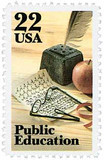
U.S. #2159
1985 22¢ Public Education in America
- Stamp celebrates 350th anniversary of the Boston Latin School, the oldest continuously operating school in the US.
- First US stamp to honor public education generally
Stamp Category: Commemorative
Set: [Name of set the stamp is part of]
Value: 22¢, first-class rate
First Day of Issue: October 1, 1985
First Day City: Boston, Massachusetts
Quantity Issued: 120,000,000
Printed by: American Bank Note Company
Printing Method: Photogravure
Format: Panes of 50 in sheets of 200
Perforations: 11
Why the stamp was issued: This issue celebrates the 350th anniversary of the Boston Latin School. Founded on April 23, 1635, the Boston Latin School is the oldest continuously operating school in the United States.
About the stamp design: In the years leading up to this stamp’s issue, there were several stamps that honored specific schools – Washington and Lee University, Columbia, and Dartmouth College. However, the USPS then decided that they should no longer honor specific schools or their anniversaries on stamps because there are too many of them.
But as the 350th anniversary of the Boston Latin School approached, it seems the USPS thought it was too significant not to honor. So, they developed the Public Education stamp. It doesn’t picture the school or include any dates relating to Boston Latin, though Uldis Purins’ design does illustrate items typically found on a Colonial Era teacher’s desk.
While the stamp didn’t appear to outright honor the school, the USPS publicized the stamp as honoring Boston Latin’s 350th anniversary. It was even initially scheduled to be issued on April 23, 1985, the school’s official anniversary. But issues with preproduction delayed the stamp and it wasn’t issued until October 1st.
First Day City: The First Day Ceremony for this stamp was held at the Boston Latin School.
History the stamp represents: On April 23, 1635, the Boston Latin School opened its doors. It’s America’s oldest school and first public school.
Puritan colonists in America knew early on that they needed a solid educational system for their children. Many of their ministers had attended Oxford or Cambridge University in England, and they particularly wanted their children to be able to read the Bible.
Reverend John Cotton developed the idea for establishing a school in Boston based on the Free Grammar School of Boston, England. Like the schools in England, it would feature a curriculum centered on religion, Latin, and classic literature. On April 13, 1635, Cotton called a meeting of local citizens and they chose Philemon Pormort to serve as the first schoolmaster. The school opened 10 days later on April 23, 1635, with the first classes being held in Pormort’s home. Classes would continue to be held at the home of the schoolmaster until 1645, when construction on the school building was completed. It was America’s first schoolhouse and resided fittingly on School Street.
Though it was a public school, it didn’t initially receive full support from taxes. Funds were raised by donations and land rentals. And many of the early students paid tuition. Harvard University was founded the year after Boston Latin, in part so that “Boston Latin’s graduates would have somewhere to go.” The school quickly came to be known as the main preparatory school for Harvard.
When the school first opened, it only admitted male students and hired only male teachers. In 1859, Helen Magill became the first female student, though co-educational classes wouldn’t begin until 1972, a few years after they began hiring their first female teachers. The school also had a cadet corps that formed during the Civil War and remained active for nearly a century.
Boston Latin School has had many famous graduates over the years, including John Hancock, Samuel Adams, Henry Ward Beecher, Charles Sumner, Ralph Waldo Emerson, Leonard Bernstein, Henry Knox, and Samuel Pierpont Langley. Benjamin Franklin attended the school, but his father withdrew him because of the cost of tuition.
The school is still open today and still requires its students to study four years of Latin. It’s been named one of the top 20 high schools in the country, serving about 2,400 students with a staff of about 130.






